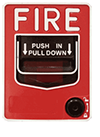Video MGMT System
 Access Control
Access Control
Voice & Data Wiring
 Burglar Alarm
Burglar Alarm
 Fire Alarm
Fire Alarm
Video MGMT System
Voice & Data Wiring
THOUGHT CENTER > Blog > Security Cameras
February 28, 2022
It wasn’t long ago that if you wanted to ensure comprehensive coverage of an area, you had no choice but to design a complex camera network. Between blind spots, lighting concerns and poor image quality over longer distances, this was the only way to ensure that you would always have convictable evidence should an incident occur.
These days, with 4K IP cameras, image processing and other advanced tools, creating a powerful surveillance system is much easier—not to mention more affordable!
Two popular options for maximizing coverage with as few cameras as possible are fisheye cameras and multi-sensor cameras. While both might seem similar at first glance, they’re quite different.
So how do you know which one to choose? We’ll break down the major pros and cons for each in this post. Let’s get started!
While both offer expanded fields of view, similarities between these camera types stop here.
A fisheye camera uses a single sensor and specialized lens to take 180- or 360-degree panoramas of the surrounding area. Due to the characteristics of the lens, the video captured is often round or oval shaped with significant distortion near the edges—also known as the “barrel effect”. In most cases, this is easily accounted for through dewarping—a process that enhanced the image either directly within the camera or at your Video Management Software (VMS) or Network Video Recorder (NVR).
Multi-sensor cameras take a different approach. Using multiple sensors and lenses, the camera captures streams in each direction and then stitches them together to create a panoramic view of the covered area. As with fisheye cameras, this can take place in the VMS or NVR. Many can also stream sensors separately if you wish. However, it’s important to note that the visual distortion present from fisheye lenses doesn’t impact video from a multi-sensor camera as most use standard lenses.
Want to make your fisheye camera wireless? Check out our commercial wireless camera solutions in New Britain CT.
If you’re considering installing a fisheye or multi-sensor camera to help protect your home or business, these considerations should help you to decide which option is best for your location and needs. In part two of this series, we’ll dive deeper into fisheye cameras to help you determine what to look for when choosing the perfect camera.
View one of our wireless security camera projects in New Britain.
Have a question we didn’t cover here? Ready to start designing your system? Mammoth Security is a leading installer and designer of surveillance systems in Connecticut! We’re available 24 hours a day to help you! Give us a call and we’ll be happy to help you find the ideal options for your needs.
NOT COMPLETELY SURE?
860-748-4292